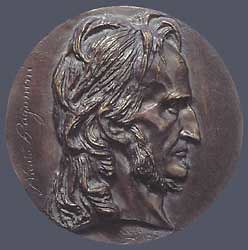
PREV ARTICLE
FULL ISSUE
PREV FULL ISSUE
FEATURED WEB SITE: RENAISSANCE OF THE CAST MEDALThis week's Featured Web page is on the renaissance of the cast medal in nineteenth century France, from the web site of David and Constance Yeats. Thanks to Ben Weiss for posting the link on his own site, www.historicalmedals.com.The medal as we know it today had its origins in the Italian Renaissance with the circular bronze commemorative portraits produced by Pisanello (c. 1395-1455) during the mid-fifteenth century. Medals are often viewed in a numismatic context because they share certain obvious characteristics with coins. Both are round, made of metal, and exhibit a portrait on the front (obverse) and an allegorical or narrative scene relating to that portrait on the back (reverse). In general, coins are produced in great numbers by a central political authority and are meant to circulate socially as a medium of exchange. Medals, however, have no intrinsic value. They are produced for many purposes: to celebrate famous people, to mark important social or political events, or to memorialize personal milestones, such as births, marriages and deaths. Until the seventeenth century, medals were often used as articles of personal adornment, attached to clothing or worn around the neck. As intimate sculpture in a double-sided relief format, medals have always been something to hold and turn in the hand--personal objects for aesthetic and intellectual contemplation. A medal can either be struck or cast--techniques developed in the classical world and perfected during the Italian Renaissance. The process of striking consists first of the preparation of the desired images on two dies followed by the impression by force of these dies onto a prepared metal blank. In antiquity and throughout the Middle Ages this force was provided by the simple act of hammering. The invention of the screw press in early sixteenth century Italy enabled medals to be struck with greater speed and control. The result is an object sharply and precisely defined, but often rather dry and lacking in sculptural elegance. Not surprisingly, striking was, and is today, the method utilized for mass production of both coins and medals. Casting requires the preparation of two original uniface models--the obverse and reverse--in wax, plaster, or less commonly, wood or stone. These models are utilized to create negative molds in a soft material such as terracotta or gesso. Once the molds have dried, they are fitted together leaving channels into which the molten metal is poured. After cooling, the medal in its raw state is removed from the mold. At this stage a careful hand finishing is required which includes filing, chasing, and often the application of chemically based patinations and thin coats of lacquer. The final result is a unique work of art, with examples of the same medal exhibiting subtle variations in color and surface detail. The earliest medals in sixteenth century France were produced by goldsmiths working in a style which combined the native Gothic heraldic tradition with an obvious awareness of Italian Renaissance portraiture. From the outset, the production of medals in France was highly dependent on the patronage of the crown. This may be viewed in comparison to the early history of the medal in Italy, where artists relied more on the commands of private patrons, resulting in the possibility of greater artistic freedom. The invitations extended by François I (1494-1547) to Italian artists and craftsmen, among them Benvenuto Cellini and the aged Leonardo, to help embellish his court at Fontainebleau demonstrate the lure that Italian aesthetic innovation had in France. 
Wayne Homren, Editor The Numismatic Bibliomania Society is a non-profit organization promoting numismatic literature. See our web site at coinbooks.org. To submit items for publication in The E-Sylum, write to the Editor at this address: whomren@gmail.com To subscribe go to: https://my.binhost.com/lists/listinfo/esylum All Rights Reserved. NBS Home Page Contact the NBS webmaster 
|